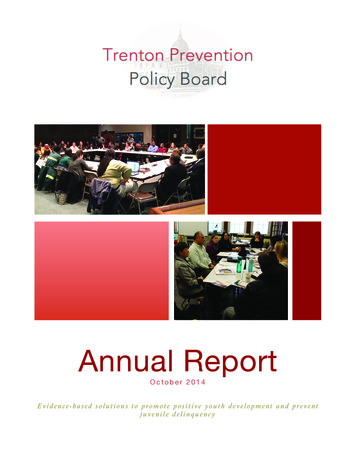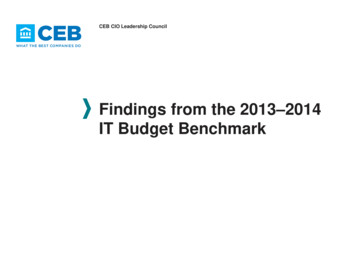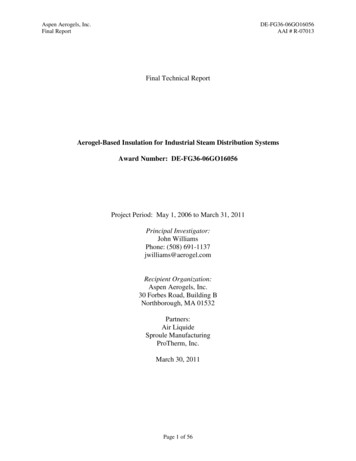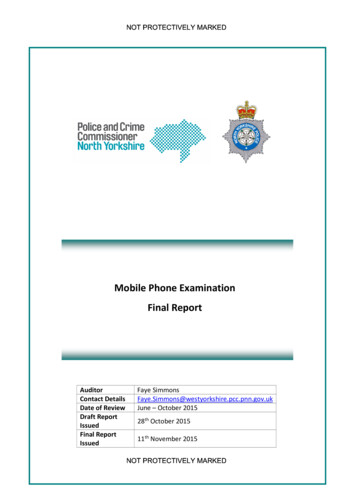
Transcription
Annual ReportOctober 2014Evidence-based solutions to promote positive youth development and preventjuvenile delinquency
TABLE OF CONTENTSIntroduction . 3Executive SummaryThe TPPB: Origins & Development in TrentonRecent Trends & the ChallengeImplementation Efforts . 8Domestic Violence Working Group Recommendations . 12Education Working Group Recommendations . 14Employment Working Group Recommendations . 17Health Working Group Recommendations . 19Juvenile Delinquency Working Group Recommendations . 23Mentoring Working Group Recommendations . 25Conclusion . 272
IntroductionEXECUTIVE SUMMARYThe Trenton Prevention Policy Board (TPPB) is a pseudo-grassroots1 effort that aims to reduce juveniledelinquency and promote positive youth development in Trenton. Approximately 75 local stakeholdersand other experts gather together once or twice a month to share their knowledge about relevanttrends, youth-serving programs, public policies, research, and best practices. They do so in order toadvance two very practical goals: to make informed recommendations to leaders in the area via theproduction of an annual report; and, to work together to implement some of those very samerecommendations by tapping into the internal resources of the TPPB network.This report begins with an update on the major recommendations that the Board offered in its firstreport in 2012. It starts with the Board’s two largest success stories: the receipt of 1.1 million to createthe Trenton Violence Reduction Strategy as well as the development of a new transition program foreighth-grade students who are moving on to high school in Trenton. The document then summarizesthe progress that has been made with respect to two important integration efforts. The first linked theneeds of high school students with the teaching objectives of The College of New Jersey’s Masters inCounselor Education program. The second connected the call for more mentors to receive training ondomestic violence issues with one of the County’s annual RFP processes. Finally, the report clarifieswhat positive steps have been taken by TPPB participants to create an employment program that issimilar to the HomeBoy Industry model.2In addition, these pages convey the newest set of recommendations that have emerged from each ofthe six TPPB working groups. These call for the development of a teacher’s handbook on domesticviolence; the creation of an ad hoc task force to help the School District comply with the 2011 TeenDating Violence law; and, a campaign that helps the District’s Family and Community EngagementOffice integrate evidence-based models into its emerging parent-engagement strategy.In regards to civic engagement and employment, the TPPB is calling for a pilot program that utilizes thearts and community service as a vehicle to promote positive youth development among at-risk teens, aswell as establishing apprenticeship programs and/or partnerships in the area. The Learn and Earnmodel would link local college programs to the needs of one or two major employers, while providing anopportunity for Trenton residents to grow their technical and/or technical skills.1We use this term to convey that the TPPB includes a significant number of non-profit and public agencyprofessionals. It is seeking funding to deliberately engage a larger number of residents and local youth.2Homeboy Industries (HBI) is a comprehensive job placement, training, and education program, founded byFather Gregory Boyle in East Los Angeles, CA. HBI has been touted as highly successful by mediaorganizations, educators, and law-makers.3
Finally, the report includes a number of recommendations to promote healthier children, young adults,and adults. It aims to increase the capacity of individual schools to identify and respond to traumatizedchildren, and promotes the creation of community-based trauma response teams for the city’s mostchallenged neighborhoods. In addition, Board members support the consistent delivery of proventeenage pregnancy prevention programs in city schools and non-profit organizations working withyoung women, as well as the opening of a residential detox center in Trenton.These recommendations, coupled with efforts already taking place within the Board, represent acoordinated effort to address some of the needs of the Trenton community and its youth. The membersof the Trenton Prevention Policy Board remain committed to the board’s mission: to advance evidencebased solutions to address juvenile delinquency and promote positive youth development in the city ofTrenton.This report was produced in collaboration with several faculty members and students from The Collegeof New Jersey who provided research and literature reviews for the recommendations detailed below.Thank you to Dr. Bruce Stout, Dr. Sandy Gibson, Dr. Stuart Roe, Heather Silivanch, Ryan Gale, andBrittany Aydelotte.4
THE TPPB: ORIGINS & DEVELOPMENT IN TRENTONAs noted in the Board’s first report in 2012, the idea of developing local Policy Planning Boards in a fewNew Jersey cities emerged during the administration of former Attorney General Anne Milgram. A fewkey staff recognized the value of having local stakeholders review the evidence, the policies, and thepractices pertaining to at risk youth, and supporting them so they could offer recommendations toprevent young people from entering into the juvenile justice system.The concept of local prevention policy boards was included in the Governor’s Strategy for Safe Streetsand Neighborhoods of 2008. The strategy called for local participants to use a “research basedframework” and focus on “risk and protective factors.” It was first deployed in Vineland, Camden,Trenton, and Newark, and has since expanded to include Asbury Park and Atlantic City.Trenton’s involvement in the initiative began in June of 2009. During the Board’s first phase, the RandInstitute of Rutgers University in Camden, NJ and the Office of the Attorney General guided participantsthrough a “data walk.” As part of this phase, participants in the process looked carefully at data fromTrenton and important indicators concerning juvenile delinquency in the city. This led to the creation offour areas of concern and consequently four working group: Education (high dropout rate); Employment(high unemployment among young adults); juvenile delinquency (high rates and the prevalence ofviolence); and, domestic violence (high number of incidents and the effect on the development ofminors). Two working groups, health and mentoring, were subsequently added in 2012 as members ofthe Board identified additional indicators and needs.The College of New Jersey assumed the lead facilitator role of the TPPB in the fall of 2011. It integratedthe needs of the Board with TCNJ’s community engaged learning objectives. Staff from the BonnerInstitute for Civic and Community Engagement joined the Board as facilitators for each working group.In addition, a team of Bonner Academic Fellows was established, linking TCNJ faculty with eachworking group to provide research and training, as well as to produce a literature review on each initialidea. Through this process, the Board ensured that the ideas that were put forth by the working groupswould be based on evidence and best practices.The leadership of the Board has evolved over time, however it includes one of the original leaders,Marygrace Billek, the Director of Mercer County’s Health and Human Services Division. Two additionalco-chairs join her: Patrick Donohue, Assistant Provost for Community Engaged Learning andPartnerships at TCNJ and, Jason Rogers, a city employee and President of Fathers and Men United fora Better Trenton. Madeline Bell of the Center for Community Engaged Learning and Research at TCNJis the staff Coordinator of the project.5
RECENT TRENDS AND THE CHALLENGEFor each of the six working group areas, there are startling statistics that highlight the challenge thatfaces this Board and others are who working to improve the quality of life in the city. These include:Ø Crime and Juvenile Delinquency — The Trenton Police Department recorded 37 homicides in2013, an all-time high for the city. There are about 480 youth on juvenile probation in MercerCounty, 80 percent of which live in Trenton, according to the Mercer Vicinage Probation Division.As of June 2012, there were close to 40 youth in detention in Mercer County.Ø Domestic Violence — The Trenton Police Department reports that a domestic violence incidentoccurs every seven minutes in the State of New Jersey. In 2013, the Trenton Police Departmentrecorded over 1,111 domestic violence incidents.Ø Education — As reported by the New Jersey Department of Education, the graduation rate forthe city of Trenton was just under 50 percent for 2012; 59.29 percent for Trenton Central HighSchool, 80 percent for Trenton Central High School West, and 7.69 percent for Daylight/TwilightHigh School.Ø Employment — The official unemployment rate in Trenton is around nine percent according tothe Trenton Health Team’s Community Health Needs Assessment, though it is likely much higherin reality. Mercer County is projected to have 2,400 job openings annually between 2014 and2014; however only 22 percent are likely to require low to moderate skill levels, and high schoolis the highest level of education for 67 percent of Trenton residents.Ø Health — The Trenton Health Team reports that the city’s rate of violent crime in 2010 was 4.5times higher than the rest of the state, exposing the Trenton’s youth to higher levels of trauma.Exposure to violence and traumatic events physically alters the development of a young person’sbrain, often leading to increased risky behaviors. Due to a pregnancy, approximately 13 percentof female students in Trenton Central High School dropped out during the 2009-2010 academic.55 percent of 2012 Mercer County substance abuse treatment admission were cases fromTrenton.Ø Mentoring — There are approximately seventeen established mentoring organizations in the cityof Trenton, and likely many more grassroots groups that provide mentoring to youth in need,according to the Trenton Mentoring Coalition. Access to information about best practices,information about funding opportunities, and trainings and workshops is limited to a select fewdue to a gap in resources.Though the Board recognizes there is much more to be done in the city, this report offers a glimmer ofhope. It captures the work of nearly 100 individuals who take the time each month to accept animportant challenge: find evidence-based solutions to help our youth stay away from or escape6
delinquency. They know if they learn and act together they can advance concrete changes that have thepotential to help young people in Trenton and the overall city. Twelve such changes are discussed in thenext section of this report; followed by the latest round of recommendations.7
Implementation EffortsAs mentioned previously, the Trenton Prevention Policy Board has assumed two roles as it workedcollaboratively over the past year. The Board labored to develop new recommendations and implementsome of the very same proposals that were discussed in the previous year’s report.First, it is worth noting that Board has followed two strategies as part of this implementation plan. Theleaders understand that there are a lot of resources even in the most challenged community; and, if theright people are united around the table, those local resources can be compiled and leveraged tosupport community interests. These resources include material support such as funding and facilities, aswell as more abstract assets including influence, knowledge, and expertise. The TPPB has effectivelytapped into these existing resources during the last year.In addition, the leaders of the TPPB understand that the best method to attract external resources is totap into the vast reservoir of expertise that lies on, and more importantly off campus. The Board’ssuccess to date is in part the result of good information, data, and research. At times, this comes fromprofessionals who have worked with youth for years, or former program participants who share theirperspective. At other times, it comes from the research literature, and often it is derived from acombination of all three.The summaries of five major implementation efforts are briefly described on the next several pages ofthis report.The Trenton Violence Reduction Strategy (TVRS)In the 2012 TPPB report, the Juvenile Delinquency Working Group recommended that the OperationCeasefire strategy be reinstituted in Trenton to reduce gun violence. The main goal of the initiative is torecruit and train outreach workers who will be able to engage high risk victims and their families, as wellas the families of those who commit violence, in meaningful dialogue about ending the cycle of violence.Workers would be able to link the victims and families to social services, distribute materials thatencourage residents not to retaliate, and organize activities that aim to defuse tension.On September 26, 2013 the New Jersey Attorney General’s Office awarded the Trenton PoliceDepartment and The College of New Jersey a 1.1 million grant to implement a hybrid version ofOperation Ceasefire, entitled the Trenton Violence Reduction Strategy (TVRS) over a three-yearperiod. The TVRS is built on evidence-based models such as Ceasefire and Project SafeNeighborhoods that have proven successful in other parts of the country. It has also been specificallytailored, based on an analysis of crime trends, to meet the specific needs of Trenton. The TVRS strategytakes a holistic approach to assisting those individuals and their families by deploying social services8
and outreach workers into neighborhoods experiencing highlevels of criminal activity. The strategy offers neededcounseling, job training, and other aid as an alternative foryoung people who might otherwise engage in criminal activity,while maintaining a firm message of deterrence through theunified efforts of federal, state, and local law enforcement forthose who refuse to change their behavior.To date, eight paid outreach workers have been hired andtrained, and connected with a caseload of five individuals andtheir families in two neighborhoods in Trenton. Isles, Inc. isserving as the lead social services agency, providing youth andfamilies in the program with necessary services, or referringparticipants to other organizations in the Trenton area. Thefirst call in meeting took place in Mach of 2014, during whichlaw enforcement personnel, social services provider, outreach workers, faith leaders, and othercommunity members spoke directly with those youth and their families who are committing or arevictims of violence. The call in meetings iterate the resources available to those in need, as well as theheightened consequences for those who continue delinquent and criminal behavior. Subsequent call inmeetings were held over the spring and summer of 2014, and a total of 24 individuals have joined theprogram, the vast of majority of which have been connected to jobs, academic programs, and otherservices.Eighth-Grade Transition ProgramAs part of its set of recommendations, the Education Working Group proposed that the eighth-gradetransition program at Trenton Central High School (TCHS) be expanded to include all eighth-graders inthe district who are moving up to TCHS. The Education Working Group collaborated with the TrentonSchool District, Mercer County Department of Human Services, and other partners including PrincetonBlairstown to develop and implement an evidence-based eighth-grade transition program in the summerof 2013.The four-week program, entitled Tornado Alley Transition Summer Experience (TASTE), providedclassroom instruction taught by Trenton Central High School teachers, brought students to TCNJ’scampus to participate in the REAL Game, an evidence-based program evaluated by the University ofMassachusetts, and included a week of adventure-based experiential education at the PrincetonBlairstown Center. The evidence-based programming was designed to help prepare students for highschool in the 2013-2014 academic school year. The partnership between TCNJ, Trenton SchoolDistrict, and Princeton-Blairstown will continue throughout the year as evaluations of the program areconducted.9
The College of New Jersey and Trenton School District are currently working together to complete anassessment of the program, the results of which will be used in organizing future programming.Higher Education Counselor Support ProjectThe Education Working Group, as part of its group of recommendations in the 2012 Annual Report,proposed that a pilot program be established in which TCNJ students in the Masters in CounselorEducation program conduct their practicum hours at a Trenton school. The program would benefitTrenton schools and students by providing additional staff to assist with the substantive counselingtasks that have been demonstrated to lead to student successes. It would also benefit TCNJ counseloreducation students, as they would receive valuable and mandated field experience under thesupervision of a full-time school counselor. As of the spring of 2014, seven TCNJ students havecompleted the program, delivering a total of 4,200 hours of counseling to the Trenton school system.Domestic Violence TrainingsSince much of the juvenile justice work is focused on mentoring programs, the Working Group onDomestic Violence wants to ensure that mentors are well prepared for this responsibility. The DomesticViolence Working Group recommended, in the 2012 Annual Report, that mentoring programs offer ongoing trainings for their mentors. In addition, mentors should be trained on how to properly respond if amentee reports having to deal with domestic violence and sexual assault at home or in their personallife. The Mercer County Youth Services Commission incorporated this recommendation into their grantawards for mentoring programs, by requiring that all requests for proposal include trainings for mentorson the impact of domestic violence on children and how to effectively respond.The Domestic Violence also helped in the implementation of this recommendation by offering three freetrainings for mentors in Trenton on how to properly respond if a mentee reports having to deal withdomestic violence and sexual assault at home or in their personal life. These workshops covered severaltopics, including domestic violence 101, media literacy, and bystander intervention with the RutgersSCREAM theater program. The sessions trained participants on how domestic violence can affectyouth, the affect of the media on young people regarding the portrayal of gender and relationshipnorms, and how to help young people understand how to address domestic and dating violence amongtheir peers. Additionally, Womanspace, Inc., a key agency in this field, continues to offer free, ongoingtraining via their Education and Training committee.Homeboy IndustriesThe Employment Working Group recommended in the 2012 Annual Report that an RFP be developedby a foundation or other major funding institution for the creation of a social entrepreneurship site,10
similar to that of “Homeboy Industries.” In its recommendation, Isles was sited as a potential site to hostthe program. Homeboy Industries (HBI) is a comprehensive job placement, training, and educationprogram, founded by Father Gregory Boyle in East Los Angeles, CA. HBI has been touted as highlysuccessful by media organizations, educators, and law-makers alike.The Employment Working Group worked with a Cost Accounting class at The College of New Jerseytaught by Professor Bea Chiang in the fall of 2013. The class began the process of developing businessmodules and identifying the true cost of developing a business that would hire youth in Trenton. Morerecently, A Better Way and CityWorks have collaborated in an effort to open a business in the city aspart of a social entrepreneurship model, similar to Homeboy Industries. The goal of the project is toestablish a for-profit business with a social justice mission, to provide those hard to employ individualsan opportunity to make a living while gaining valuable work experience.11
Domestic Violence Working GroupRecommendationsDating partners are responsible for 44 percent of homicides for female youth, ages 15 to 18, withAfrican-American youth disproportionately affected. i Dating violence during adolescence is alsoassociated with other negative outcomes, including: poor health, depression, sexual risk behavior,pregnancy, substance abuse, unhealthy weight control, sexually transmitted infections, physical injuryand suicidality.ii Exposure to non-fatal dating violence during adolescence may also have a negativeimpact on physical and emotional health, and the capacity to form healthy relationships both in theimmediate and long-term future.iii There were 1,111 domestic violence calls in the city of Trenton in2013.Despite broad calls for primary prevention, few programs with demonstrated effectiveness exist.iv Whenexploring best practice for prevention of dating violence in adolescence, it quickly becomes clear thatinterventions must start young, very young, if long-term, sustained outcomes of violence-free adolescentdating relationship are to be recognized. ‘Prevention’ programs that are administered in high schoolstend to be ‘interventions’ rather preventative, responding to existing attitudes and/or behaviors regardingdating violence. This is not to indicate that such interventions are not needed, but rather, to demonstratethat the opportunity to change the culture and beliefs about dating relationships must be addressedmuch earlier in life.Teacher’s Handbook on Domestic ViolenceThe Domestic Violence Working Group is interested in working with the Trenton School District toproduce a handbook for teachers regarding domestic violence. Such a manual would provide teacherswith information on how to recognize and support students affected by domestic violence orinterpersonal violence. One model of this type of approach can be found in the State of Vermont, whichhas developed the Vermont Teacher Handbook on Domestic Violence. The handbook answers severalquestions, including: (1) what are the signs of domestic violence?; (2) how can I support the student?;(3) how can I deal with the challenging behaviors at school?; (4) where can I get help for the family?; (5)how can I talk to the mother?; and, (6) what encourages healing?The TPPB Domestic Violence Working is currently working with Womanspace to modify this publication,with the publisher’s permission, to make it appropriate for New Jersey teachers. The manual will bedistributed to the Directors of Guidance in schools throughout Mercer County.12
Domestic Violence Prevention LegislationGovernor Christie signed the Teen Dating Violence bill into law in May of 2011, with it going into effect inSeptember of that year. The law requires schools to provide education on dating violence, and toestablish prevention policies. This law requires dating violence education in Health/PE curriculum forgrades seven through 12, and it must be covered every year through those grades. It also requires theuse of a structured curriculum, however, there is no specific curriculum mandated by the law. The TPPBDomestic Violence Working Group recognizes the value of this last component, as schools will not beable to merely “talk about it” briefly and deem themselves compliant.To date, many school districts have not complied with this law. To date, the Domestic Violence WorkingGroup has been unable to find any evidence of the programs or a district policy in Trenton publicschools. It appears that Trenton School District is currently noncompliant with this law. This workinggroup will work to educate the Trenton School District about the legal mandate for such education in theschools and policy development, and offer support in identifying appropriate curriculum in the drafting ofdistrict policy.13
Education Working GroupRecommendationsAlthough education is described as a major asset for Mercer County, with five colleges and universitieslocated within the county, there is a major disparity in equal access to that education. The TrentonSchool District has less than a 50 percent graduation rate, and only 64.5 percent of city residentsacross the six zip codes have graduated from high school.v To some degree, the problem starts withtruancy; several middle schools in the city had over 20 percent of their students qualify as chronicallyabsent (missing 10 percent of the school year or 18 days) during the 2012-2013 academic year.vi3Not surprisingly, there is a significant relationship between the educational outcomes, delinquentbehavior, and societal costs. According to the National Center for Education Statistics, the UnitedStates would substantially reduce its public health, criminal justice, and welfare costs by cutting highschool dropout rates in half; it would also gain an additional 45 billion in tax revenues.viiParental Engagement CampaignEducation researchers continue to support the notion that effective parent involvement in schools iscrucial to students’ academic success. As evidenced by a number of recent studies, those studentswith a significant adult involved in their learning are more likely to be successful in schools.viii In fact,family involvement has a positive impact on children regardless of the cultural backgrounds of thefamilies, their income, or their parent’s education levels. ix The literature proves that well-plannedoutreach and school-based programs can increase parental engagement, particularly among parentswho have been considered hard to reach.xWhile there are a number of models for increasing parental engagement, the most prominent andevidence-based approaches have been informed by Epstein’s Typologies.xi Epstein’s model encouragesreformers to recognize six important facts: (1) Parents need help learning about child development andthe resources that are available to them and in establishing home environments that are conducive tolearning; (2) Communication involves fostering effective, timely, appropriate, two-way communicationabout school events as well as student progress in school and in the home; (3) Providing meaningfulvolunteer opportunities gives parents and community members the chance to support and advance themission of the school; (4) To promote learning at home, school personnel must provide culturallyappropriate resources and activities to help parents learn how to best support their children at home(such as clear homework expectations and the importance of setting aside time for homework, etc.); (5)Parents and community members should be involved in decision making processes at school, not3One middle school had a chronically absent rate of 56 percent in the 2012-2013 academic school year.14
simply called on when advocacy efforts are needed; and, (6) True Collaboration with the communitycalls on school personnel to identify and - to the extent possible - integrate community resources intothe school to meet the needs of families, students, and school employees.Many successful parental engagement programs start with a parent engagement committee and someschool districts have found it useful to hire a parent engagement coordinator who is committed to theseengagement efforts. And, many have found that developing a family-school partnership policy thatdescribes how the school, parents, and the community are committed to the success of every studentis a good place to start. The Trenton School District has shown signs that it is moving in this directionand is dedicated to promoting parental engagement among all parents, even those of young peopleinvolved in the truancy or juvenile justice system.The Education Working Group recommends that the TPPB should work closely with the new Family andCommunity Engagement (FACE) Office within Trenton School District as well as the Trenton ParentTeacher Association to foster more parental engagement. Specifically, it should help take stock of thestatus of current parent engagement programs and examine ways that existing practices are linked tostudent achievement. In addition, it should also advance the development and adoption of a parentengagement strategy that is based on the Epstein model. The first phase of this strategy should includea plan for a school-based pilot approach or one that is citywide. In addition, the Working Group shouldcontinue to conduct research on best practices, including finding a successful Parent University modelthat may work in Trenton.Civic Engagement and Youth with Increased Risk FactorsWhile the District may see stronger education outcome figures if parents become more involved, thesame may be true if young adults themselves have opportunities to be more engaged.Despite recent increases in youth civic participation, less educated and low-income youth - particularlyAfrican Americans, Asians, and Hispanics - continue to report lower rates of civic engagement thanWhites, as well as higher attrition out of civic activities from one year to another. xii In general, theliterature agrees that it is important to individuals to develop a civic identity based on (1) a sense ofconnect
needs of high school students with the teaching objectives of The College of New Jersey's Masters in Counselor Education program. The second connected the call for more mentors to receive training on . teenage pregnancy prevention programs in city schools and non-profit organizations working with . the needs of the Board with TCNJ's .










